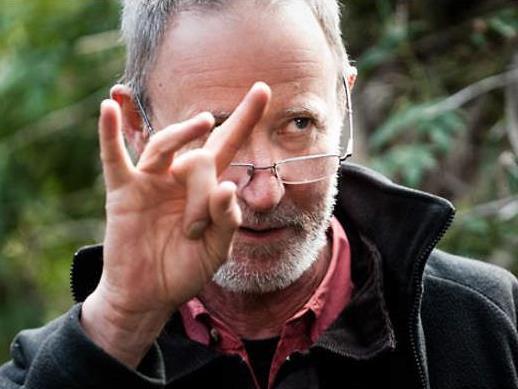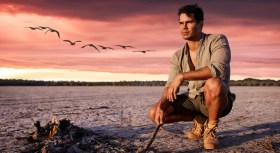Image: Rolf de Heer at work.
Rolf de Heer brought the same lean elegance that infuses his films to his contribution to the first AFTRS 8X8 event in July 2018.
He is one of the most distinctive voice in Australian cinema, whose fourteen feature films include Encounter at Raven’s Gate, Dingo, Bad Boy Bubby, Dance Me To My Song, The Tracker, Alexandra’s Project, Ten Canoes and Charlie’s Country.
Thanks to AFTRS for allowing us to republish his contribution, and to Rolf de Heer for making it, and allowing it to spread.
Rolf de Heer: 8×8 –
I have eight minutes. Time for eight thoughts, if I’m fast.
Thought number one. I have been working for the past few years on a complex Australian, Chinese, German, Swiss, Ukrainian co-production.
The Australians feel the story is largely an Australian story. The Ukrainians think that, at its heart, it’s wholly, a Ukrainian story. The Germans don’t much care whose story it is. They simply want the co-production to work. The Swiss are just delighted that they are part of this co-production, and the Chinese though they very much like the project as it is, would really rather it was a fully Chinese story, which it’s not.
All of this has naturally had me had quite a few thoughts about what is an Australian story, particularly because I went from being Australian to being Dutch for the purposes of this co-production, and then back to being Australian, and now I’m not so sure who or what I am.
Second thought. It seems to me that there’s a chasm of difference between an Australian story and an Australian storyteller. Wake In Fright, the 1971 film, is certainly an Australian story, one of the best to have been committed to the screen. The source material, Kenneth Cook’s novel, was Australian. The primary storytellers of the film, however, were anything but Australian. Screenwriter Evan Jones was Jamaican. Director Ted Kotcheff is Bulgarian-Canadian. Actors Gary Bond and Donald Pleasance were both British. English. But it’s an Australian story through and through.
Baz’s Moulin Rouge was nothing like an Australian story, though it was a thoroughly Australian-told story, writers, director, lead actress all being Australian.
Three. Having sorted out for myself the difference between an Australian story and an Australian storyteller, I have a third disconnected thought about stories. 300 years ago, Johann Sebastian Bach was composing some pretty sublime music in what is now Germany. His music lasts to the present day, everywhere, including in Australia and no one since has composed anything like it. One can wonder why not, but the answer is relatively straight forward: Bach was a product of his time. Equally, his music was a product of its time.
The Brandenburg Concertos could only have been composed in 1721 or thereabouts and St. Matthew’s Passion could only have been composed in 1727, or thereabouts, after the Brandenburg Concertos. All good art, and some bad art as well, is of its time.
This led me to a fourth thought. I think of two Australian films that were of their time: 1972 film The Adventures of Barry MacKenzie, though set largely in England, is very much an Australian story, told by Australian storytellers.
Apart from being a huge success in England, the film was a major success in Australia. Crocodile Dundee is also unquestionably, for me, an Australian story despite some of it being set in New York. And it was also told by Australian storytellers, and we all know what a success that was all over the world.
In their time, both films were significant. Barry MacKenzie was a very early film of the Australian Renaissance and its success gave pride and confidence to our nascent industry. Apart from making us laugh, it’s been estimated that Croc Dundee has indirectly contributed as much as 20 billion dollars to the Australian economy.
Are these two films culturally or artistically important now, like Bach’s cantatas are? I don’t think so. Looking at them today, they just seem like pretty bad films. It’s true, true. But then think about Wake In Fright, released in Australia just before Barry MacKenzie. Not important in Australia then and rejected at the box office, but a significant cultural record and still a great film even today.
Five. Having been in China a bit lately, I see what is happening to their particularly Chinese industry. It’s Americanising, because that’s what the audiences seem to largely want. The shape of many of the Chinese stories is morphing into an American shape.
Thought number six. For some reason I think there’s a sort of connection between interesting abstract art and Australian screen storytelling. I think of the 1968 National Gallery of Victory’s abstract art exhibition, The Field, and its current restaging as The Field Revisited. I don’t know what it would have been like at the time, but its reincarnation is thrilling. In 1968, however, the view was mostly somewhat different. The Melbourne Herald art critic — they had one then — saw this exhibition as a threat to the national identity, and was quite concerned by what the exhibition meant for Australian art.
The artists themselves weren’t interested in the question of ‘what is Australian art’? Art for them was, is, global.
Seven. I was part of the third intake into this school, not this building, in 1977. That, at the time, made us a complete school for the first time, having 20 students in each of the three years of the fulltime program.
There was no talk of Australian stories. In Professor Toeplitz’s most illuminating weekly history of cinema talks and screenings, there was no mention of Australian stories, nor was there in any of the other workshops. There was simply cinema. [ed: Professor Jerzy Toeplitz was the founding director of both the Polish Film School and AFTRS, where de Heer became a student in 1977].
Eight. And eight. I look at the screen-hungry young people around me, the one-year-old in a pram with a screen in front of them to keep them quiet. The five-year-old in a café with a screen in front of her to keep her quiet, and well behaved. The kids in the other room all with screens to keep them quiet and well behaved so the adults can drink and have some fun.
None of those kids, and neither the adults, I suspect, give a rat’s arse about whether the stories or the storytellers are Australian. They just want the stories to be good. That’s a fairly decent argument for dispensing with even the idea of Australian stories or, for that matter, Australian storytellers. For the vast majority of screen story consumers, it doesn’t matter where the stories come from. Stories are global.
So perhaps we should just vacate the field. Forget about Australian stories, just think stories, stories that people want. Global stories, perhaps. No more support for the outdated concept of Australian stories. No doubt that would please many an economist and free marketeer. But it doesn’t please me.
I don’t want to be American. I don’t want my kids to be culturally and attitudinally American. And there’ll be nothing to prevent that from happening if we stop supporting Australian stories and Australian storytellers. Thank you.





